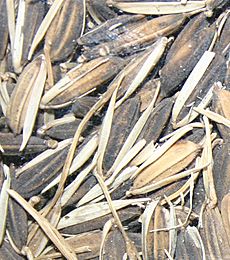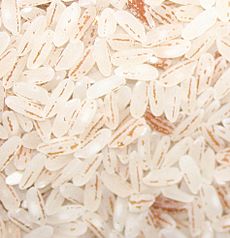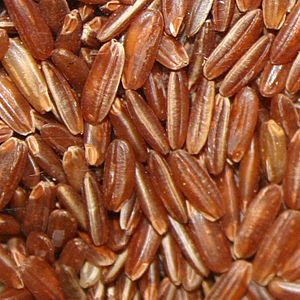Brown rice facts for kids
Brown rice is a whole grain rice with the inedible outer hull removed. White rice is the same grain without the hull, the bran layer, and the cereal germ. Red rice, gold rice, and black rice (also called purple rice) are all whole rices with differently pigmented outer layers.
Cooking time
Brown rice generally needs longer cooking times than white rice, unless it is broken or flour blasted (which perforates the bran without removing it). Studies by Gujral and Kumar in 2003 estimated a cooking time between 35 and 51 minutes.
Modifications
Parboiled rice is a modified process that forces into the kernel some of the vitamins found in the hull before the hull is removed. The process provides more nutrition than white rice while shortening the time necessary for final meal preparation.
Storage
Brown rice has a shelf life of approximately 6 months, but hermetic storage, refrigeration or freezing can significantly extend its lifetime. Freezing, even periodically, can also help control infestations of Indian meal moths.
Arsenic
Rice plants accumulate arsenic, and there have been concerns over excessive arsenic levels in rice. There is more arsenic in the bran, so brown rice contains more arsenic. The European Union has introduced regulations on arsenic in rice, but the United States has not.
Natural arsenic levels in groundwater and soils vary. Rice grown in some regions contains less arsenic than others. Arsenic from pesticides and poultry fertilizer may be taken up by rice.
A 2012 report from the US publication Consumer Reports found measurable levels of arsenic in nearly all of the 60 varieties of rice and rice products it tested in the US. Consumer Reports states that brown rice has 80 percent more inorganic arsenic on average than white rice of the same type, because the arsenic tends to accumulate in the outer layers of the grain. Its 2013 analysis found that rice cereal and pasta can possess significantly more inorganic arsenic than the 2012 data showed; Consumer Reports said just one serving of rice cereal or pasta could place children over the maximum amount of rice it recommended for their weekly allotment, due to arsenic content. One study published in the Proceedings of the National Academy of Sciences journal found a median level of arsenic that was 56% higher in the urine of women who had eaten rice.
Composition
| Nutritional value per 100 g (3.5 oz) | |
|---|---|
| Energy | 1,548 kJ (370 kcal) |
|
77.24 g
|
|
| Sugars | 0.85 g |
| Dietary fiber | 3.52 g |
|
2.92 g
|
|
|
Protein
|
7.85 g
|
| Vitamins | Quantity
%DV†
|
| Thiamine (B1) |
35%
0.401 mg |
| Riboflavin (B2) |
8%
0.093 mg |
| Niacin (B3) |
32%
5.091 mg |
| Pantothenic acid (B5) |
30%
1.493 mg |
| Vitamin B6 |
39%
0.509 mg |
| Folate (B9) |
5%
20 μg |
| Minerals | Quantity
%DV†
|
| Calcium |
2%
23 mg |
| Iron |
11%
1.47 mg |
| Magnesium |
40%
143 mg |
| Manganese |
178%
3.743 mg |
| Phosphorus |
48%
333 mg |
| Potassium |
7%
223 mg |
| Selenium |
33%
23.4 μg |
| Sodium |
0%
7 mg |
| Zinc |
21%
2.02 mg |
| Other constituents | Quantity |
| Water | 10.37 g |
| †Percentages estimated using US recommendations for adults. | |

African rice in its inedible husk (seed rice, will sprout)
|

The same rice, with almost all bran and germ removed to make white rice
|
Nutritional content
Brown rice and white rice have similar amounts of calories and carbohydrates. Brown rice is a whole grain and a good source of magnesium, phosphorus, selenium, thiamine, niacin, vitamin B6, and manganese, and is high in fiber. White rice, unlike brown rice, has the bran and germ removed, and therefore has different nutritional content.
Brown rice is whole rice from which only the husk (the outermost layer) is removed. To produce white rice, the next layers underneath the husk (the bran layer and the germ) are removed leaving mostly the starchy endosperm.
Several vitamins and dietary minerals are lost in this removal and the subsequent polishing process. Among these are oil in the bran, which is removed along with the bran layer, dietary fiber, small amounts of fatty acids, and magnesium. A part of these missing nutrients, such as vitamins B1 and B3, and iron, are sometimes added back into the white rice. In the US the result is called "enriched rice" and must comply with Food and Drug Administration (FDA) regulations for this name to be used.
It has been found that germinated grains in general have nutritional advantages. Germinated brown rice (GBR), developed during the International Year of Rice, is brown rice that has been soaked for 4–20 hours in warm 40 °C (104 °F) water before cooking. This stimulates germination, which activates various enzymes in the rice, giving rise to a more complete amino acid profile, including GABA. Cooked brown rice tends to be chewy; cooked GBR is softer, and preferred particularly by children.
See also
 In Spanish: Arroz integral para niños
In Spanish: Arroz integral para niños



